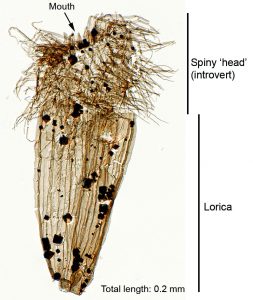
Dr Tom Harvey from the Department of Geology, University of Leicester, together with Professor Nicholas Butterfield, University of Cambridge, discovered the new species while conducting a survey of microfossils in mudstones from western Canada.
To their surprise, the samples yielded miniscule loriciferans: a type of animal so small it has been considered “unfossilizable”.
Moreover, the fossils date to the late Cambrian Period, meaning they lived around half a billion years ago. This suggests that soon after the origin of animals, some groups were adopting specialized “meiobenthic” lifestyles, living among grains of sediment on the seabed.
Funded by the Natural Environment Research Council (NERC), the scientist have co-authored a paper in the journal Nature Ecology & Evolution.
Dr Harvey, a Lecturer in Geoscience at the University of Leicester, said: “I discovered the fossil loriciferans by accident while surveying other types of microfossil: this required many hours working at the microscope.
“I kept finding mysterious fragments which looked like the back ends of loriciferans, but I told myself it was impossible.
“Finally, however, I found an exceptionally well-preserved specimen with a fossilized head still in place, proving its identity as a loriciferan. Then began the delicate task of cleaning the fossil and securing it on a microscope slide.
“Luckily I did this without breaking the specimen, by holding my breath and trying to keep a steady hand…”
Loriciferans are a group of miniscule animals, always less than a millimetre long, which live among grains of sediment on the seabed. They are easy to overlook: the first examples were described from modern environments as recently as the 1980s.
Dr Harvey added: “As well as being very small, loriciferans lack hard parts (they have no shell), so no-one expected them ever to be found as fossils – but here they are! The fossils represent a new genus and species, which we name Eolorica deadwoodensis, loosely meaning the “ancient corset-animal from rocks of the Deadwood Formation.”
“It’s remarkable that so early in their evolution, animals were already exploiting such specialized meiobenthic ecologies: shrinking their bodies down to the size of single-celled organisms, and living among grains of sediment on the seabed.”
Dr Harvey’s area of research is the application of fossils to understand the origin and early evolution of animals. In particular, he looks at exceptionally well-preserved microscopic fossils to work out when the earliest animals lived, what they looked like, and how they fed, moved, and interacted with one another and their environment.
He said: “By studying the earliest fossil animals, we can trace the history of our own evolution and find out how life on Earth came to be so diverse. Unknown to many people, there is a hidden world of tiny animals inhabiting the spaces between sand grains on beaches and under the sea. Despite their small size, these animals are an important link in the food chain, and they help recycle nutrients in marine ecosystems. The discovery of specialised microscopic loriciferans shows that as long ago as the Cambrian Period (around half a billion years ago), some animals had already adapted to this specialized, cryptic way of life. Therefore, the ecological range of early animals has been underestimated, and we will have to think again about how these early ecosystems worked.”
“The dramatic diversification of animals known as the Cambrian “explosion” is a source of fascination to many people. Working out why animals evolved when they did, and how they came to dominate almost all ecosystems on Earth, is a longstanding scientific question that affects how we think about our place in the universe.”
The scientists added that the new fossils also support a close relationship between loriciferans and another obscure group of animals (the priapulid worms), helping to piece together the tree of animal life.
Dr Harvey used a specially designed laboratory technique to extract the delicate microfossils from mudstone, using strong acid combined with gentle sieving. This allowed the tiny fossils, which are less than half a millimetre long, to be extracted from the rock – revealing a previously hidden aspect to early animal life on Earth.
He said: “We have developed a new technique for extracting delicate microscopic fossils from ancient rocks, promising to shed new light on early animal evolution
“We also now have a search-image for very small fossil animals. Perhaps they are extremely rare – or perhaps they are widespread, but have been overlooked. Hopefully more will now come to light, giving further insights into when tiny animals first evolved, and how they diversified to eventually become such an important component of modern ecosystems.”
Reference:
Thomas H. P. Harvey et al, Exceptionally preserved Cambrian loriciferans and the early animal invasion of the meiobenthos, Nature Ecology & Evolution (2017). DOI: 10.1038/s41559-016-0022
Note: The above post is reprinted from materials provided by University of Leicester.










